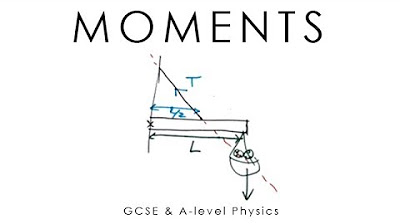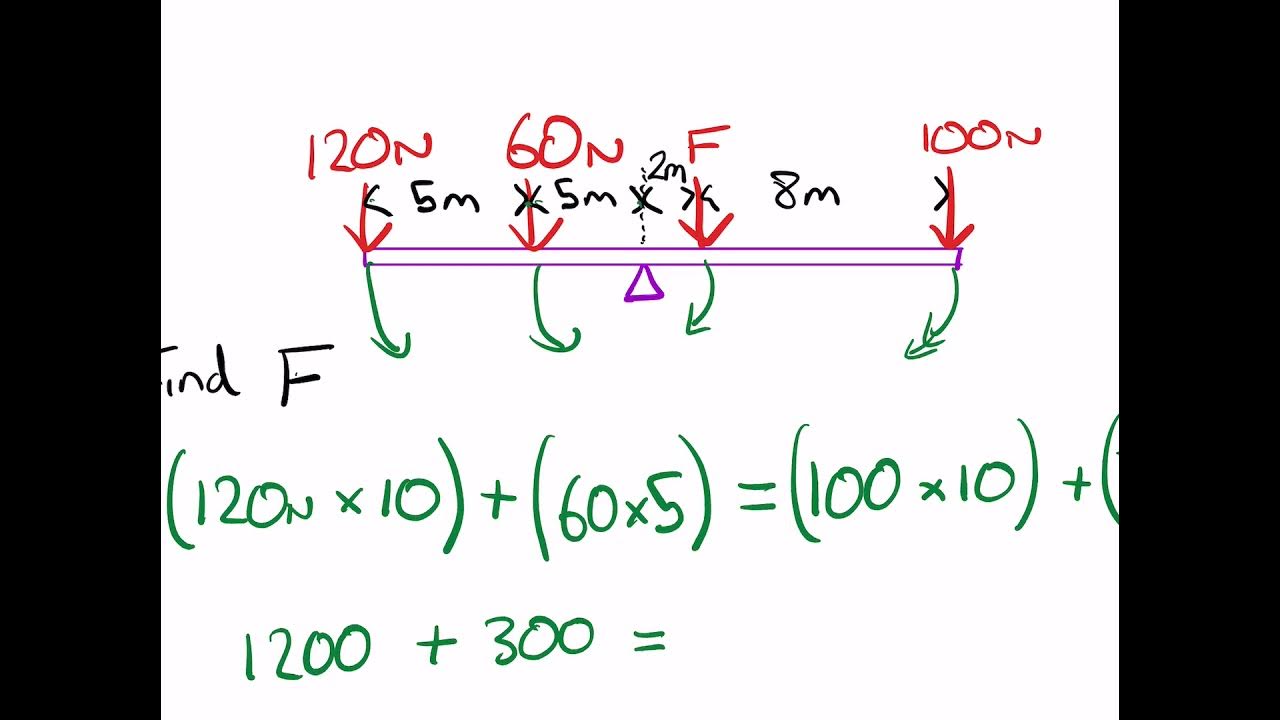Principle of Moments - Physics Revision
TLDRThis video script explains the principle of moments, a fundamental concept in physics for determining equilibrium. It uses the example of a seesaw to illustrate how the moments (force times distance) on either side must be equal for balance. The script guides viewers through the calculation process using a man weighing 500 Newtons 1.5 meters from the pivot and another man weighing 600 Newtons at an unknown distance 'd'. By applying the principle of moments, the video shows how to solve for 'd', emphasizing the importance of understanding and applying this principle for physics problems.
Takeaways
- 📚 The script explains the mathematical method used in the principle of moments, which can be confusing but is essential for solving equilibrium problems.
- 🔍 The moment is defined as the force applied multiplied by the perpendicular distance to the pivot point.
- 🤔 An example is given involving a seesaw where a person is standing at the edge, 1.5 meters from the pivot, with a weight of 500 newtons.
- 🤹♂️ The script poses a question about balancing the seesaw with another person who weighs 600 newtons, and introduces the concept of clockwise and anti-clockwise moments.
- ⚖️ The principle of moments states that in equilibrium, the total clockwise moments must equal the total anticlockwise moments.
- 📝 The solution involves writing down the principle of moments as the first step in solving the problem.
- 🔢 The calculation for the unknown distance 'd' is demonstrated by multiplying the force (weight) by the distance from the pivot, and setting it equal to the moment on the other side of the seesaw.
- 🧐 The script shows the process of making 'd' the subject of the equation by dividing the moment caused by the first person by the weight of the second person.
- 📈 The result of the calculation is 1.25 meters, which is the distance the second person must stand from the pivot to balance the seesaw.
- 📚 The script emphasizes the importance of stating the principle, substituting numbers, and rearranging the equation to solve for the unknown.
- 🎓 The video is intended as a revision aid for students learning physics, with an encouragement to subscribe for more content.
Q & A
What is a moment in the context of physics?
-In physics, a moment is the product of the force applied and the perpendicular distance from the pivot point, which is used to analyze the balance of a system.
What is the principle of moments used for?
-The principle of moments is used to determine the equilibrium state of a system, ensuring that the total clockwise moments are equal to the total anticlockwise moments.
In the example provided, what is the weight of the man standing on the left side of the seesaw?
-The weight of the man standing on the left side of the seesaw is 500 newtons.
How far is the first man from the pivot point on the seesaw?
-The first man is 1.5 meters away from the pivot point on the seesaw.
What is the weight of the second man who needs to stand on the right side of the seesaw to balance it?
-The second man's weight is 600 newtons.
What is the unknown distance from the pivot point to the second man standing on the right side of the seesaw denoted as?
-The unknown distance is denoted as 'd' in the script.
How can you calculate the distance 'd' using the principle of moments?
-You calculate 'd' by setting the total clockwise moment equal to the total anticlockwise moment, and solving for 'd' by dividing the moment on the left side by the weight of the man on the right side.
What is the moment on the left side of the seesaw when the first man stands there?
-The moment on the left side is the product of the man's weight (500 newtons) and the distance from the pivot (1.5 meters), which equals 750 newton-meters.
How do you rearrange the equation to solve for 'd'?
-To solve for 'd', you divide the moment on the left side (750 newton-meters) by the weight of the second man (600 newtons), resulting in 'd' being 1.25 meters.
What is the final position of the second man to balance the seesaw according to the principle of moments?
-The second man must stand 1.25 meters from the pivot point on the right side of the seesaw to balance it.
What is the main takeaway from the script when solving problems using the principle of moments?
-The main takeaway is to state the principle of moments, substitute the given values, and rearrange the equation to solve for the unknown variable, ensuring the system is in equilibrium.
Outlines
📚 Understanding the Principle of Moments
This paragraph introduces the principle of moments in physics, which is a mathematical method used to determine the balance point of a lever system. It explains that the moment is the product of the force applied and the perpendicular distance from the pivot point. The paragraph uses a practical example of a person standing on a seesaw to illustrate the concept. It describes a scenario where a person weighing 500 newtons stands 1.5 meters away from the pivot, causing the seesaw to tilt. The task is to find the position of another person weighing 600 newtons to balance the seesaw. The principle of moments is applied by setting the total clockwise moments equal to the total anticlockwise moments, leading to a calculation that determines the required distance 'd' for the second person to stand to achieve equilibrium.
Mindmap
Keywords
💡Moment
💡Pivot
💡Seesaw
💡Equilibrium
💡Clockwise Moments
💡Anticlockwise Moments
💡Force
💡Distance
💡Subject
💡Rearranging
💡Physics
Highlights
The mathematical method of the principle of moments can be confusing but is solvable by following specific steps.
A moment is defined as the force applied times the perpendicular distance to the pivot.
An example is given involving a person standing on a seesaw to illustrate the principle of moments.
The first person is 1.5 meters from the pivot with a weight of 500 Newtons, causing the seesaw to tilt.
The problem asks where a second person, weighing 600 Newtons, should stand to balance the seesaw.
The principle of moments states that in equilibrium, total clockwise moments must equal total anticlockwise moments.
The solution involves writing the principle of moments as the first line of the solution.
The right-hand side person provides the clockwise moment, calculated as force times distance (600 Newtons * d).
The left-hand side person provides the anticlockwise moment, calculated as 500 Newtons times 1.5 meters.
The calculation of the right-hand side moment results in 750 Newton-meters.
To find the unknown distance d, divide 750 by 600 Newtons, yielding 1.25 meters.
The process involves stating the principle, substituting numbers, and rearranging to solve for the unknown.
The summary emphasizes the steps to solve a problem using the principle of moments.
The transcript provides a clear method to apply the principle of moments in physics problems.
The example used in the transcript is practical and relatable, aiding in understanding the concept.
The transcript encourages viewers to subscribe for more physics content.
The transcript is aimed at helping with revision and understanding of the principle of moments.
Transcripts
Browse More Related Video

Turning Forces (Moments)

Moments, Torque, Toppling & Couples - GCSE & A-level Physics (full version)

The Principle of Moments - A Level Physics

GCSE Physics - Moments worked examples

Physics 15 Torque (20 of 25) More Examples: 2 F=? of Screw on Bracket

How to Calculate Force | plus | How to Calculate Distance | Physics |
5.0 / 5 (0 votes)
Thanks for rating: